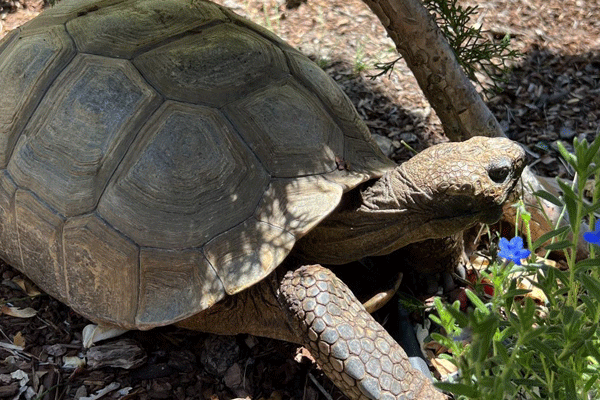Tortie, an 80-year-old California desert tortoise, is back to his old self after undergoing surgery to remove a fist-size bladder stone, which was discovered during a wellness examination.

The octogenarian reptile was taken in for the exam by his new owners, Cal and Michelle. Tortie is a lifelong pet for Cal, having been acquired by his parents more than 60 years ago.
As a new reptile owner, Michelle scheduled a wellness examination for Tortie, which is when the bladder stone was discovered. From there, the tortoise was referred to the exotic companion animal specialists at the University of California, Davis (UC Davis) veterinary hospital.
The stone would need to be removed, UC Davis reports. If not, it would continue to grow and damage Tortie’s vital organs.
“Tortie is a great example of the importance of annual wellness examinations,” says David Guzman, LV, MS, DECZM (Avian, Small Mammal), DACZM, chief of the Companion Exotic Animal Medicine and Surgery Service at UC Davis. “Thankfully, his owners chose to get a hibernation consultation, but the stone could have been identified even earlier with an annual examination, and that smaller stone could’ve been removed much easier.”
To remove the stone, two approaches were considered. The first option, a plastronotomy, involved making an invasive cut through the bottom of Tortie’s shell, which would allow the surgeons to reach and remove the stone.
Dr. Guzman, and resident Mariana Sosa Higareda, MVZ, opted, instead, to attempt a less invasive procedure, proposing to surgically enter Tortie’s body cavity through an area in front of his back leg (the prefemoral fossa) and, using endoscopy tools to access the bladder, break up the stone and remove it.
“While this procedure is less invasive, it still presented some challenges,” Dr. Higareda says. “We needed to get good exposure to the bladder through such a small opening and also come up with techniques to break down such a large stone and remove the pieces.”
Following three hours of surgery, the massive stone was completely broken down and removed, confirmed by endoscopic examination and a post-operative X-ray. Since it was expected Tortie would not eat on his own for some time following the surgery, a feeding tube was placed to help it receive proper nourishment and hydration, as well as easily administer medication. The slower metabolism of reptiles makes them notorious for their slow recovery from anesthesia, and Tortie took nearly 24 hours to become fully awake. During that time, the tortoise was closely monitored in the hospital.
To the university’s knowledge, Tortie is the oldest veterinary patient to ever undergo surgery at UC Davis. The reptile received recheck examinations at two weeks and six weeks post-surgery, and is now doing well at home.
For more, click here.
